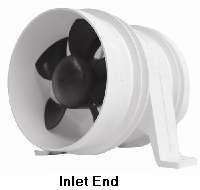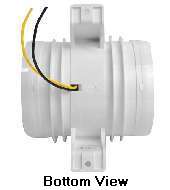The MGA With An Attitude
BILGE BLOWER To Cool Carburetors -- CB-207
In the mid 1990's North America was transitioning from regular gasoline to "gasohol" with 10% alcohol in the fuel. Alcohol has about 40% less energy than gasoline per unit volume, so it is expected to make less power (unless the engine is modified), and will likely give about 4% lower fuel economy. For our older carburetor cars the greater problem appears to be the lower boiling point of alcohol causing fuel to boil in the carburetors during hot driving conditions, like stop and stop traffic on a hot day. Vapor in the bubbles contains far less fuel than liquid, so the fuel mixture goes lean, and it may require manual choke to make the engine run properly. The hotter it gets the more choke is required. This is is often casually referred to as "vapor lock" (although it is not technically correct). When the car sits with engine off for a few minutes after hot running it may require full choke and half throttle to re-start.
In standard configuration, air flow through the MGA cowl vents transitions from outward to inward at about 25 mph. This is entirely due to build up of air pressure in front of the windscreen, which reaches farther forward at higher speed. I have some practical experience with this from my more active autocross days in the late 90's. After a hot lap around the track I would open the bonnet for cooling in between runs. It was common to find the rear carburetor dashpot warm, but I could hold my hand on it, while the front carb was too hot to touch for more than a couple of seconds. It was quite obvious that cool air was entering the cowl vent to cool the rear carb more than the front one. On hot days when the competition runs were less than 10 minutes apart I could occasionally trickle water on the carburetors to help them cool off between runs.
Some time ago it was suggested by John Twist of University Motors, Ltd., to use a 4-inch bilge blower to increase air flow through the heater box to improve both heating and cooling for the passengers. Considering configuration of the forward air ducts in the MGA, it is casually obvious that the same device could be used to blow cool air on the carburetors. It is also assumed that you don't need that much air flow to cool the carburetors, so the smaller 3-inch blower might do just as well for that purpose.



The Attwood blowers running free flow at discharge end produce a 30 mph wind from the 4" unit (230-cfm) and 33.6-mph wind (145-cfm) from the 3" unit. Apparently the different size blowers use the same motor, and the blower with the smaller fan runs faster. Attwood defines a "system" with a 3-foot duct, one 90-degree bend, a collector box, and a louvered discharge vent. This might be fairly close to the flow resistance you have in this MGA application. In the "system" Attwood shows 125-cfm for the 4" unit and 100-cfm for the 3" unit. This is more like 16-mph for the 4" unit and 23 mph for the 3" unit. This is why I like the idea of placing the 3" unit in the steel duct blowing directly at the carburetors. It would be a smaller diameter air stream at higher velocity.
These will definitely do a good job of cooling the front carburetor. Some of this induced air flow (maybe most of it) will flow out the cowl vent at slow ground speed, meaning the cool air will flow right past both carburetors (or at least past the air cleaners). It will be interesting to find at what ground speed it might transition from outward flow to inward flow (if ever). If it does ever transition to inward flow at the cowl vent, then both the inward cowl vent flow and the blower flow will be directed at the carburetors. Considering the input air velocity from the blower, and the direction of travel, I suspect this would create a swirl effect in the engine bay where some of the cool air would travel to the rear corner and then somewhat across the heater shelf area before exiting below the chassis. This may even have some small cooling effect on the upper bulkhead and heater shelf (although I doubt that anyone will even notice that or ever measure it).
The more we chat about this the more anxious I am to give it a try. This discussion leads to a number of people testing the blowers as noted in the following pages.
|


